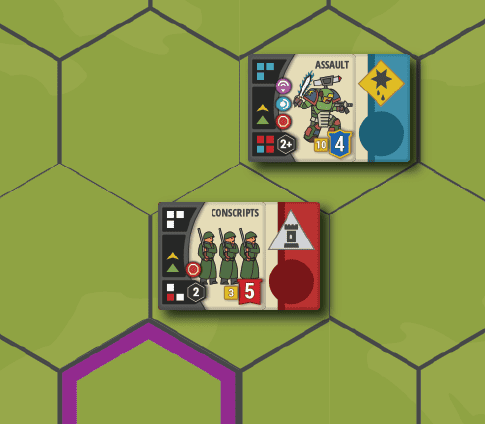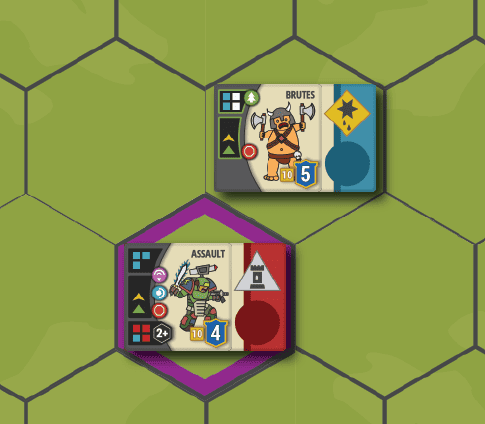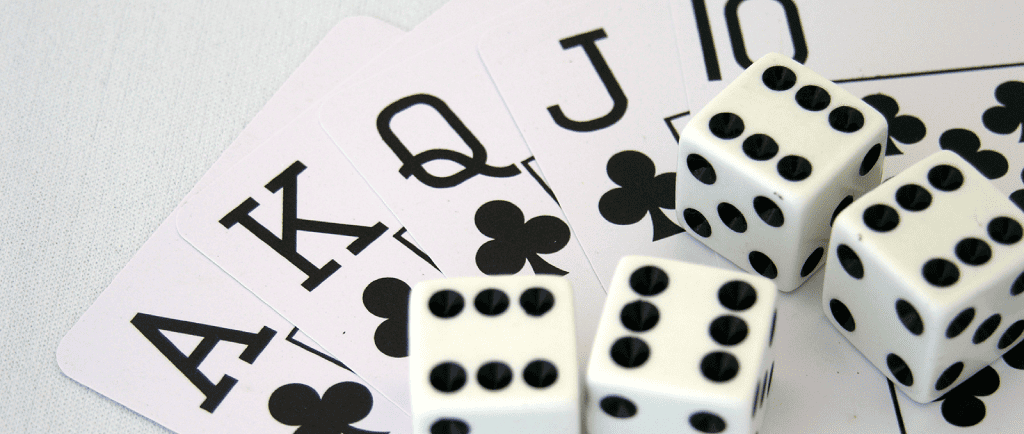Tension: the uncertainty gap. The distance between desire and potential.
From a game design perspective, I define tension as the anticipation of changes in fortune. Games that are good at building tension are games that keep you biting your nails until the last second. There are lots of ways to do it right, and more ways to do it wrong. Good ways of building tension are clear, keep the player involved, and focus the gameplay. Bad ways are obscure, disempower the players, and distract from or ignore other parts of the game.
When I started designing Ars Victor, I lucked out by finding a really cool way to build tension: The Glory Track. It quickly became a foundation of the game. It’s one of the things that makes Ars Victor so fun, and I want to share how it does that.
WHAT’S AN ARS VICTOR?
Ars Victor is my two-player game of sci-fi tactical combat. It’s a descendant of Memoir 44, the Command & Colors games, Battlelore, etc. Thematically, each player commands a fighting force, which you use to destroy your enemy. Mechanically, gameplay is fast and focused. This family of card-driven battlefield wargames uses cards to limit a player’s decisions, and simple rules keep movement and combat quick and decisive.
Ars Victor takes this family of games into a endless science-fiction future. It starts with the fundamentals of the card-driven battlefield wargame. It provides a simple and accessible set of rules that gives you a sci-fi slugfest in an hour or less. And it does this in a way that allows for limitless replayability.
The Glory Track lies at the heart of Ars Victor.

HOW IT WORKS
The Glory Track determines when the game ends, and who wins when it does. It’s quite simple:
- Each player starts with a number of points on the Glory Track.
- You reduce your opponent’s glory by killing their units and controlling the board.
- The game ends when one player hits zero glory.
- You win if you’re the other player!
The two things that affect the Glory Track — killing units and controlling the board — are what Ars Victor is all about.
Killing Units. Each piece in the game has a point value, from the cheap 3-point Conscripts to the expensive 10-point Field Gun. When you eliminate your enemy’s unit, you knock down their Glory by the point value of the unit. It’s not enough to just do damage; you have to remove the unit from the board.
Capture Points. There are three colored Capture Points that are spread out across the middle of the battlefield. When you begin your turn with a unit sitting on one, you knock down your enemy glory by one point. Each player also has a special Headquarters piece, that is sort of like your King in Chess. If you occupy a Capture Point with your HQ, you knock your enemy for one extra point.
THE GLORY TRACK IN PRACTICE
The track does a wonderful job of focusing your attention on what you need to do to win the game. It provides a common coin with which you can express the trade-offs you need to consider for every move: are you threatening enemy units? exposing your own units? are you gaining control over the board or are you giving it to your opponent?
What’s really cool is that many of these trade-offs drive you to make decisions that capture the feel of tactical combat.

SKIRMISHING & DELAYING.
You want to keep your enemy off the points. One of the most effective ways of doing that is by putting your units in the way. There’s even a special ability (Standfast) that lets some units hold ground at the cost of extra damage.
When you’re considering throwing your cannon-fodder Conscripts in front of that rampaging Assault Infantry, how do you know if it’s worth it?
- Your Conscript can take 5 hits before dying, and you’ll lose 3 points of Glory when they do. And they WILL die if you put them in front of that Assault Infantry.
- But how long will they be able to keep the Assault Infantry off the nearby Capture Point? That’s one Glory you save for every turn they do.
An Assault Infantry throws three blue dice in close combat. It will take them at least two turns, and probably three, to wipe out that Conscript. That’s three turns that you’re denying them the capture point. More importantly, that’s three attacks that your enemy has to pay for, before they can even start to approach the capture point.

HOLD THE LINE!
An enemy Brutes are trying to push your Assault Infantry off a point. They roll a hit and a push. Do you:
Use Standfast to convert the push to a second hit, and hold the point.
Use Take Cover to convert the hit to a second push, and fall back.
Again, look to the Glory Track to help inform that decision:
- Two hits on your Assault Infantry takes out half of a 10-point unit. You can roughly translate that into a 5-point cost to holding ground.
- Holding the point will knock down your enemy’s glory by one if you hold it for one more turn.
That may seem like a no-brainer: it’s not worth it to lose half of your Assault Infantry to hold the point for one more turn! But that comparison doesn’t tell the whole story. If your opponent only has one point of Glory left, you absolutely want to take the hits — you’ll win on your next turn! Similarly, if you have a massive Glory advantage, or a plan to save your Assault Infantry on the next turn, it might be worth it to risk your 10-point unit. You don’t lose those points unless they’re totally wiped out.
THE PSYCHOLOGY OF COUNTING DOWN
When I originally designed the Glory Track, I discovered something interesting: the fact that it was a “count down” system instead of a “count up” system had a subtle but important effect on player motivation. For some reason, it really helped with morale for players that were on the wrong end of a beat-down. Consider these two models:
COUNT-DOWN MODEL:
- Red has 20 Glory left to lose before Blue wins
- Blue has 5 Glory left to lose before Red wins
COUNT-UP MODEL:
- Red has 15 Glory and needs 5 more to win
- Blue has 0 Glory and needs 20 more to win

The Count-Down model seems to inspire Blue a lot more than the Count-Up model. With the Count-Up model, they have a huge deficit that they have to make up in order to “catch up” to Red.
Even though it’s mathematically equivalent, the Count-Down model changes mental ownership of the scores. Blue is no longer struggling to *improve* his score, he’s struggling to *defend* it. And instead of feeling powerless against Red’s ability to increase her score, he is driven to make her pay for her victory.
ADDED BONUS: THE GAMBLE
I’ve avoided mentioning how much Glory you start with, because that’s one of my favorite things about the Glory Track: it depends.
Each player’s starting Glory is based on how many points they didn’t spend on their army. I’ll save an in-depth discussion of it for another blog post, but here’s the basics: If you bring a big, expensive army, you’re going to start with less Glory than the player who brought a cheaper, weaker force. It’s a beautifully self-balancing system that makes army building a lot of fun and dramatically increases replayability.
It’s also great because it starts creating tension as soon as the game begins. One player is likely to have a Glory advantage over the other. The player who has less Glory has a stronger force, and the onus is on them to make use of it. The dramatic stage is set, and the tension builds before the first move is made.
WHAT DO YOU THINK?
If you’ve played Ars Victor, what are some of the tensest moments you’ve had in a game? How did the decisions that players made get expressed in terms of the Glory Track?
What other titles do a really good job of building and maintaining tension throughout the game? What do you attribute that to?
I’ll be posting more about the parts of Ars Victor that make it so much fun. In the meantime, you can find out more on the Ars Victor web site, our BGG page, and our Facebook page!







